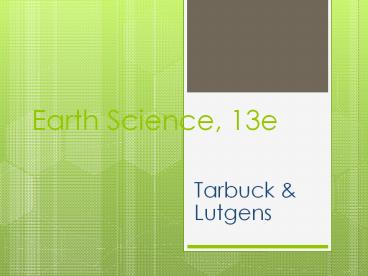Earth Science, 13e - PowerPoint PPT Presentation
Title: Earth Science, 13e
1
Earth Science, 13e
- Tarbuck Lutgens
2
Introduction to Earth ScienceEarth Science,
13eChapter 1
- Stanley C. Hatfield
- Southwestern Illinois College
3
Warm up
- List your 4 vocabulary words with definitions.
4
Earth Science
- Encompasses all sciences that seek to understand
- Earth
- Earths neighbors in space
- Earth Science includes
- Geology literally the study of Earth
- Oceanography a study of the ocean
5
Earth Science
- Earth Science includes
- Meteorology the study of the atmosphere and the
processes that produce weather - Astronomy the study of the universe
6
People and the environment
- Environment
- Surrounds and influences organisms
- Physical environment encompasses water, air,
soil, and rock - Term environmental is usually reserved for
those aspects that focus on the relationships
between people and the natural environment
7
People and the environment
- Resources
- An important focus of the Earth sciences
- Includes water, soil, minerals, and energy
- Two broad categories
- Renewable can be replenished (examples include
plants and energy from water and wind) - Nonrenewable metals (examples include metals
and fuels)
8
People and the environment
- Population
- Population of the planet is growing rapidly
- Rate of mineral and energy usage has climbed more
rapidly than the overall growth of population - Environmental problems
- Local, regional, and global
9
People and the environment
- Environmental problems
- Human-induced and accentuated
- Urban air pollution
- Acid rain
- Ozone depletion
- Global warming
- Natural hazards
- Earthquakes
- Landslides
10
People and the environment
- Environmental problems
- Natural hazards continued
- Floods
- Hurricanes
- World population pressures
11
Scientific inquiry
- Science assumes the natural world is
- Consistent
- Predictable
- Goal of science
- To discover patterns in nature
- To use the knowledge to predict
12
Scientific inquiry
- An idea can become a
- Hypothesis (tentative or untested explanation)
- Theory (tested and confirmed hypothesis)
- Paradigm (a theory that explains a large number
of interrelated aspects of the natural world) - Scientific method
- Gather facts through observation
- Formulate hypotheses and theories
13
Scientific inquiry
- Scientific knowledge is gained through
- Following systematic steps
- Collecting facts
- Developing a hypothesis
- Conduct experiments
- Re-examine the hypothesis and accept, modify, or
reject - Theories that withstand examination
- Totally unexpected occurrences
14
Early evolution of Earth
- Origin of Earth
- Most researchers believe that Earth and the other
planets formed at essentially the same time - Nebular hypothesis
- Solar system evolved from an enormous rotating
cloud called the solar nebula - Nebula was composed mostly of hydrogen and helium
15
Early evolution of Earth
- Origin of Earth
- Nebular hypothesis continued
- About 5 billion years ago the nebula began to
contract - Assumes a flat, disk shape with the protosun
(pre-Sun) at the center - Inner planets begin to form from metallic and
rocky clumps - Larger outer planets began forming from fragments
with a high percentage of ices
16
The Nebular hypothesis
17
Early evolution of Earth
- Formation of Earths layered structure
- As Earth formed, the decay of radioactive
elements and heat from high-velocity impacts
caused the temperature to increase - Iron and nickel began to melt and sink toward the
center - Lighter rocky components floated outward, toward
the surface - Gaseous material escaped from Earths interior to
produce the primitive atmosphere
18
Earths Spheres
- Hydrosphere
- Ocean the most prominent feature of the
hydrosphere - Nearly 71 percent of Earths surface
- About 97 percent of Earths water
- Also includes fresh water found in streams,
lakes, and glaciers, as well as that found
underground
19
Earths Spheres
- Atmosphere
- Thin, tenuous blanket of air
- One half lies below 5.6 kilometers (3.5 miles)
- Biosphere
- Includes all life
- Concentrated near the surface in a zone that
extends from the ocean floor upward for several
kilometers into the atmosphere
20
Earths Spheres
- Solid Earth
- Based on compositional differences, it consists
of the crust, mantle, and core - Divisions of the outer portion are based on how
materials behave - Lithosphere rigid outer layer
- Divisions of Earths surface continents and
ocean basins
21
Earths layered structure
22
Earth system science
- Earth is a dynamic body with many separate but
highly interacting parts or spheres - Earth system science studies Earth as a system
composed of numerous parts, or subsystems - System any size group of interacting parts that
form a complex whole
23
Earth system science
- System
- Closed systems are self-contained (e.g., an
automobile cooling system) - Open systems both energy and matter flow into
and out of the system (e.g., a river system)
24
Earth system science
- Feedback mechanisms
- Negative-feedback mechanisms resist change and
stabilize the system - Positive-feedback mechanisms enhance the system
- Earth as a system
- Consists of a nearly endless array of subsystems
(e.g., hydrologic cycle, rock cycle)
25
Earth system science
- Earth as a system
- Sources of energy
- Sun drives external processes such as weather,
ocean circulation and erosional processes - Earths interior drives internal processes
including volcanoes, earthquakes and mountain
building - Humans are part of the Earth system
26
Create a visual that includes and
incorporatesthe nebular hypothesis and the
Earths SpheresDescribe the steps of the
Nebular HypothesisDescribe each sphere
27
Warm up 8/28/13
- Finish your poster!
- Name the four spheres
- Explain each sphere
28
Warm up
- Name the four spheres
- Explain each sphere
- Get out your scavenger hunt































